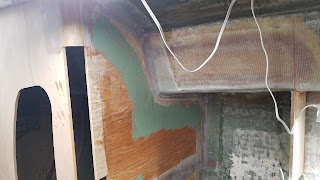Over the last few weeks I've placed the rest of the major interior bulkheads, settee faces, and other bits that extend down to the sole. I'd like to focus on getting the sole down, and I need to finish up these items before I can do that.
Sharp corners on boats hurt. I milled some white ash to make approximately 2.25" radius corners. It was a bit of trigonometry to figure it out, but they came out okay. Not perfect, but good enough.
I didn't really know what all this interior would look like so, as per the plan, I've been designing my way forward. Having decided at the last minute to move the nav station aft shifted the port settee forward. The hull comes in too tight there to allow the settee to turn into a berth, so I had to bump it in about a foot on the last forward 18 inches. I'm not sure how all the corners above it are going to work out.
The radiused white ash corner pieces are merely filleted on the inside with epoxy and woodflour. I'll glass the outsides with 10oz fabric later.
Turning to the aft end of the cabin, I tacked in athwarthship galley bulkheads/cabinet faces, and the fore'naft head bulkhead. That last one really helped define the companionway space. I was eager to get the long bulkhead under the companionway in to really get the feel.



I spent a fair bit of time puzzling over the galley toe kicks. The aft counter will house the sink, and the toekick below it will have two foot pumps for salt and freshwater, so I made it extra high - about 8 inches. The forward toekick will be 3.5 inches high once the sole is in.
Right about this time I went back and reviewed advice I'd received from
David Tyler on the JRA a few years ago about whether to extend all these bulkheads down to the bilge. It turns out I've not done it the way he recommended and I decided. The plan was to get the sole down after only the major bulkheads were in place, and all these would go down over that. Apparently it keeps the lockers dryer. Oops. I'm not going back now.

































